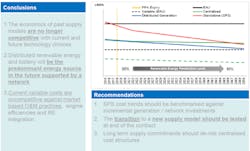of One Step Off the Grid describes how a utility leads the switch to microgrids in Western Australia.
The shift from traditional centralized fossil fuel power generation to distributed renewable energy powered grids is widely accepted as a foregone conclusion by players in the global energy market. How quickly this will happen, however, is not.
For energy networks like Western Australia’s (WA) Horizon Power, for example, which averages one customer every 33-square miles and already operates 37 microgrids ranging from 30 MW peak load to 100-150 kW, this future will arrive sooner, rather than later.
“We believe that the future will be distributed energy, particularly in these small microgrids,” said Laurie Curro, Horizon’s general manager of power system services, in a presentation at Australian Energy Week 2016 in Melbourne last week.
“Centralized energy will be there in some form or other, but distributed energy will be the way to go.” And it will be the way to go, he added, because of cost.
“Centralized energy will be there in some form or other, but distributed energy will be the way to go.”
This is in stark contrast with the Northern Territory’s state-owned power generator which, as we reported here on Monday, has been exemplifying the “old way of thinking” about energy generation that has underpinned the gold-plating in Australia’s grid in recent years.
First it responded to a major black-out by announcing $75 million in new gas-fired generation and nothing in renewables – a decision state treasurer Dave Tollner sought to justify by claiming that when the sun shines, “or the wind starts to blow, and suddenly the cables are overloaded, they heat up, melt, collide and fail.”
And then it claimed that it would cost up to $2 billion to power the city of Alice Springs with nothing but solar power, and would require enough solar and storage capacity to be built to provide electricity for seven days with no sun.
Next door in WA, however, a different picture is emerging.
“Because we run small microgrids we see (the shift to distributed generation) accelerating at a fast rate,” Curro said. The company estimates that distributed energy – rooftop solar and battery storage and other local generation – will leap from 1 percent now to more than 50 percent by 2025.
And that is based on the most economic outcome. By 2050, it suggests, centralized generation will be reduced from 98 percent now to just 9 per cent.
[clickToTweet tweet=”Western Australian Utility Leads Switch to #Microgrids @HorizonPower_WA” quote=”Western Australian Utility Leads Switch to Microgrids”]
And because the economics for the transition are so much more powerful in the remote and isolated grids that Horizon operates, Curro says Horizon’s experience will provide “a bit of a test bed” for the larger grid, and some of the solutions the still government-owned network is looking at may turn out to be a solution for the larger grid as well.
“We are looking at what other benefits we can get from this (shift to renewables),” he told the conference.
“So whether the distributed energy is owned by us or by somebody else, it doesn’t really matter, where the social demographic is such that people can’t afford to put their own systems in, we will probably put our own systems somewhere down the end of the street, batteries, etc. So we’ll approach a distributed energy future as much as we can, mainly because it is cost effective.
“Can we use the system for other things? Can we use the batteries for other things? Can we install the batteries ourselves and have other people maybe buy into it – a community type situation?
“Our challenge is not so much load, it’s more around making sure our customers can get some sort of supply. …We operate 38 grids within WA. One is the interconnected grid and the rest are microgrids.
“Storage will be a game changer and control, the ability to manage these systems, will also be the key to it,” he said.This graph above further illustrates the economic argument. The thick black line is business as usual, while other options – going stand-alone, focusing on distributed generation, are clearly much cheaper. “The economics of past supply models are no longer competitive with current and future technology choices,” it says.
Curro said Horizon was working on a project called Blueprints, which was looking at the cost of supply for all its towns and “seeing what triggers we have and what opportunities we have.”
“Solar and storage is the key to this,” he said. “In about 30 of those 38 systems we don’t actually own that generation, the generation is provided by a third party. So as those contracts come of age, we look for the opportunity to basically do something else.”
This article was reposted with permission from One Step Off The Grid.







